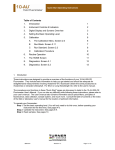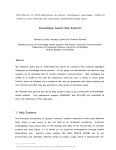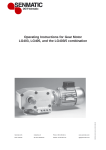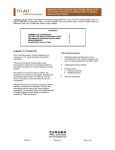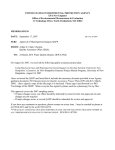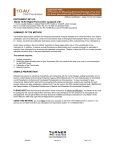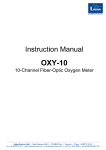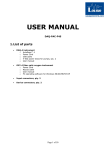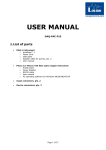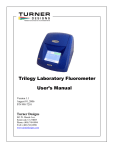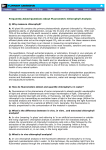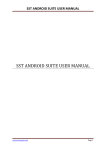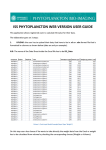Download Chlorophyll - Water Research Center
Transcript
Standard Operating Procedure for In Vitro Determination of Chlorophyll a in Freshwater Phytoplankton by Fluorescence LG405 Revision 06, March 2002 Standard Operating Procedure for In Vitro Determination of Chlorophyll a in Freshwater Phytoplankton by Fluorescence TABLE OF CONTENTS Section Number Subject 1.0 SCOPE AND APPLICATION . . . . . . . . . . . . . . . . . . . . . . . . . . . . . . . . . . . . . . . . . . 1 2.0 SUMMARY OF METHOD . . . . . . . . . . . . . . . . . . . . . . . . . . . . . . . . . . . . . . . . . . . . . 1 3.0 SAMPLE HANDLING AND PRESERVATION . . . . . . . . . . . . . . . . . . . . . . . . . . . . . 1 4.0 INTERFERENCES . . . . . . . . . . . . . . . . . . . . . . . . . . . . . . . . . . . . . . . . . . . . . . . . . . 1 5.0 EQUIPMENT REQUIRED . . . . . . . . . . . . . . . . . . . . . . . . . . . . . . . . . . . . . . . . . . . . . 1 6.0 REAGENTS . . . . . . . . . . . . . . . . . . . . . . . . . . . . . . . . . . . . . . . . . . . . . . . . . . . . . . . 2 7.0 PREPARATION OF CHLOROPHYLL a STANDARDS . . . . . . . . . . . . . . . . . . . . . . 2 8.0 CALIBRATION . . . . . . . . . . . . . . . . . . . . . . . . . . . . . . . . . . . . . . . . . . . . . . . . . . . . . 3 9.0 CALIBRATION OF SECONDARY STANDARDS . . . . . . . . . . . . . . . . . . . . . . . . . . . 4 10.0 PROCEDURE . . . . . . . . . . . . . . . . . . . . . . . . . . . . . . . . . . . . . . . . . . . . . . . . . . . . . . 4 11.0 CALCULATIONS . . . . . . . . . . . . . . . . . . . . . . . . . . . . . . . . . . . . . . . . . . . . . . . . . . . 6 12.0 QUALITY CONTROL . . . . . . . . . . . . . . . . . . . . . . . . . . . . . . . . . . . . . . . . . . . . . . . . 6 13.0 WASTE DISPOSAL . . . . . . . . . . . . . . . . . . . . . . . . . . . . . . . . . . . . . . . . . . . . . . . . . 6 14.0 REFERENCES . . . . . . . . . . . . . . . . . . . . . . . . . . . . . . . . . . . . . . . . . . . . . . . . . . . . . 6 Page ANALYTICAL CHLOROPHYLL A CALCULATION SHEET . . . . . . . . . . . . . . . . . . . 8 10-AU FLUOROMETER SOLID STANDARD CALIBRATION RECORD . . . . . . . . . 9 Disclaimer: Mention of trade names or commercial products does not constitute endorsement or recommendation for use. Standard Operating Procedure for In Vitro Determination of Chlorophyll a in Freshwater Phytoplankton by Fluorescence Standard Operating Procedure for In Vitro Determination of Chlorophyll a in Freshwater Phytoplankton by Fluorescence 1.0 SCOPE AND APPLICATION 1.1 This method provides a procedure for the fluorometric determination of chlorophyll a in freshwater phytoplankton, employing narrow band optical filters. 1.2 This method is based on that originally published by Welschmeyer (1994), and is applicable to waters from the Great Lakes. 2.0 SUMMARY OF METHOD 2.1 Chlorophyll-containing phytoplankton in a measured volume of sample water are concentrated onto a glass fibre filter by low-vacuum filtration. 2.2 After sonication, pigments are extracted in 90% buffered acetone, for 16 to 24 hours at -20.0°C. The extracted slurry is removed by filtration, and fluorescence of the extract read. The concentration in the natural water sample is reported in :g/L. 3.0 SAMPLE HANDLING AND PRESERVATION 3.1 Samples should return from the field frozen and wrapped in aluminum foil. Samples should be stored frozen (-20°C) in the dark until analyzed. Filters can be stored frozen for as long as 3 ½ weeks without significant loss of chlorophyll a (Weber et al., 1986). 3.2 Analysis should be carried out under subdued (green) light to prevent photodecomposition of chlorophyll a. 4.0 INTERFERENCES 4.1 Spectral interferences resulting from fluorescence of the accessory pigment chlorophyll b, and the chlorophyll a degradation product pheophytin a, can result in overestimation of chlorophyll a concentrations. However, the highly selective optical filters used in this method minimize these interferences. 4.2 Previous work with this method has shown maximum interferences from chlorophyll b and pheophytin a to be +6% and +10%, respectively (Welschmeyer, 1994; Arar, 1994). LG405, Revision 06, March 2002 Page 1 of 9 Sampling and Analytical Procedures for GLNPO’s WQS 5.0 EQUIPMENT REQUIRED 5.1 Turner Designs Digital Fluorometer equipped with: 10-113 Excitation Filter (436-nm), and 10-115 Emission Filter (680-nm), high intensity F4T.5 blue lamp Plastic Filter Funnel, Gelman (300-mL with magnetic base) Vacuum System (1-4 psi) GF/F Filters, Whatman (47-mm) 16 x 100 mm Screw Cap Culture Tubes 13 x 100 mm Culture Tubes, Disposable 250-mL Filter Flask with Sidearm Nalgene Tubing 1 200-mL Volumetric Flask 5 100-mL Volumetric Flasks 1 50-mL Volumetric Flask Aluminum Foil Parafilm Spectrophotometer Disposable Glass Pipettes 20.0 :g/L Chlorophyll a Calibration Standard (available from Turner Designs) Solid secondary Chlorophyll a Standards (available from Turner Designs) High Purity Grade Acetone (1 L) Magnesium Carbonate Filter Forceps Vacuum Source 6.0 REAGENTS 6.1 Saturated Magnesium Carbonate Solution: Add 10 grams magnesium carbonate to 1000 mL of de-ionized water. The solution is allowed to settle for a minimum of 24 hours. Only the clear “powder free” solution is used during subsequent steps. 6.2 90 % (v/v) Buffered Acetone: Add 100 mL of the Magnesium Carbonate solution (6.1) to 900 mL of acetone in a 1-L volumetric flask. 7.0 PREPARATION OF CHLOROPHYLL a STANDARDS 7.1 Primary standards of chlorophyll a in 90% acetone will be ordered from Turner Designs (845 W. Maude Avenue Sunnyvale CA 94086, 408 749-0994). If stored at -20°C in the dark, standards are good for one month from their receipt from Turner Designs. 7.1.1 7.2 Standards come in an ampule, which is broken and poured directly into the cuvette. Approximate concentration is 20.0 :g/L. Actual concentration varies by lot, and is listed on a certificate of analysis to three significant figures. Solid secondary standards, also available from Turner Designs, will be used for daily calibration check standards. This standard is valid for two years. Page 2 of 9 LG405, Revision 06, March 2002 Standard Operating Procedure for In Vitro Determination of Chlorophyll a in Freshwater Phytoplankton by Fluorescence 7.2.1 Secondary standards come sealed in a holder that fits directly into the 10-AU’s 13-mm test tube adaptor. The holder contains two ready-to-use fluorometric standard concentrations: approximately 30.0 :g/L and approximately 4.0 :g/L. 8.0 CALIBRATION 8.1 The following instructions apply to the Turner Designs 10-AU digital fluorometer. Calibration should be performed once prior to the analysis of samples from each survey. Allow the instrument to warm-up for at least 15 minutes. Have ready a blank of 90% buffered acetone and the calibration standard. These are to be maintained at room temperature (23 - 25°C), a water bath is recommended. 8.2 Start Calibration 8.3 8.2.1 To begin calibration, from the Main Menu, press <2> to access screen 2.0, Calibration. 8.2.2 Set the concentration range control to MAN. From screen 2.0, press <4> to bring up screen 2.4, then <3> to bring up screen 2.43 (set conc. range control), and press <ENT> to toggle. 8.2.3 Change to the desired concentration range (i.e., HIGH), from screen 2.4, press <2> to bring up screen 2.42 (change concentration range), and press <ENT> to toggle. Return to screen 2.0. 8.2.4 From screen 2.0, press <2> to access screen 2.2 (standard solution concentration). Enter the actual concentration of the calibration standard (e.g., 155 g/L). Run Blank 8.3.1 To run blank, press <1> to access screen 2.1. Make sure #2 on screen 2.1 reads YES. Then from screen 2.1, press <1> to call up screen 2.11. Because temperature affects fluorescence, do not allow the blank to remain in the instrument any longer than necessary for a stable reading. 8.4 8.3.2 Fill a clean 13-mm culture tube with the blank of 90% acetone. Put the blank in the sample chamber and replace the light cap. After the Blank % reading is stable (“TC” on screen 2.11 cycles from 1 to 8 seconds) and assuming the Blank % is less than 200%, press <0>. When “FINISHED” appears, press <ESC>. 8.3.3 Remove the blank. Set cuvette aside. Run Calibration Standard Solution 8.4.1 On screen 2.0, press <3> to bring up screen 2.3. 8.4.2 FS is the maximum concentration or relative fluorescence you will be able to read on a particular range, and it is not necessary or likely that FS match the value of the calibration standard. For example, if you are calibrating on the MED range with a 25 g/L standard, LG405, Revision 06, March 2002 Page 3 of 9 Sampling and Analytical Procedures for GLNPO’s WQS you would want to adjust the Span % until the FS for the MED range is approximately 30 (meaning you will be able to read samples up to 30 g/L on the MED range). 8.4.3 Fill a clean 13-mm culture tube with the chlorophyll a standard. Put the standard in the sample chamber and replace the light cap. Adjust the Span % using the UP and DOWN arrows until the FS readings for each range are satisfactory. Pressing the UP arrow increases Span % (sensitivity), but decreases FS. Pressing the DOWN arrow decreases Span %, but increases FS. Wait until readings are stable (“TC” on screen cycles from 1 to 8 sec.), then press <*>. When “FINISHED” appears, press <ESC>. 8.4.4 If the LOW range reads OVER, with the Span % close to 0, it means the standard concentration is too high for the LOW range. Press <ESC>, change to the MED range on screen 2.42, and return to step 8.2. Similarly, if the MED range reads OVER, with the Span close to 0%, it means the standard concentration is too high for the MED range: press <ESC>, change to the HIGH range on screen 2.42, and return to step 8.2. 9.0 CALIBRATION OF SECONDARY STANDARDS 9.1 This procedure only has to be done once for each solid standard. These standards are stable for at least two years, and can subsequently be used as daily check standards, as outlined below. 9.2 Place the solid secondary standard in the instrument, so that the ‘low’ value (approximately 4.0 :g/L) is to be read. Replace the light cap. 9.3 Wait 15 seconds for the reading to stabilize. Record the reading on the solid standard calibration record sheet. 9.4 Reorient the solid standard so that the ‘high’ value (approximately 30.0 :g/L) is to be read. Replace the light cap. 9.5 Wait 15 seconds for the reading to stabilize and record the reading of the solid standard on the calibration record sheet. 10.0 PROCEDURE 10.1 Sample Preparation 10.1.1 Add 10 mL of 90% buffered acetone (6.2) to the tube containing the filter. Recap tube and invert tube 3 times, making sure that the filter is totally submerged in buffered acetone solution. 10.1.2 Place each tube in an ultrasonic bath that had been previously filled with ice, for 20 minutes. 10.1.3 After 20 minutes, return sample tube to freezer (-20.0°C) to steep for 16 to 24 hours. 10.2 Instrument Preparation 10.2.1 Samples should all be maintained at room temperature during analysis. Page 4 of 9 LG405, Revision 06, March 2002 Standard Operating Procedure for In Vitro Determination of Chlorophyll a in Freshwater Phytoplankton by Fluorescence 10.2.2 Allow the fluorometer to warm up for at least 15 minutes prior to analysis. 10.2.3 Access screen 2.43 by pressing, successively, <2>; <4> and <3>. Set the concentration range control to AUTO, using <ENT> to toggle. 10.3 Daily Check Standard 10.3.1 Place the solid secondary standard in the instrument, so that the ‘low’ value is to be read. Replace the light cap. 10.3.2 Wait 15 seconds for the reading to stabilize and log the reading on the chlorophyll a data sheet. 10.3.3 Reorient the solid standard so that the ‘high’ value is to be read. Replace the light cap. 10.3.4 Wait 15 seconds for the reading to stabilize and log the reading on the chlorophyll a data sheet. 10.3.5 Daily check standard values should be ± 10% of their previously determined values. If they are not, the instrument may have to be recalibrated. Speak to the Biology Team Leader before proceeding with sample analysis. 10.4 Sample Analysis 10.4.1 Invert the sample test tube 4 times to mix. 10.4.2 Using the filter flask with a sidearm attached to a vacuum unit, filter the entire contents of the sample through a GF/F (47-mm) filter, directly into the 13 x 100 mm disposable culture tube used for analysis. Rinse filter holder with acetone prior to filter of the next sample. NOTE: Do not let the vacuum pressure exceed 1-2 psi or the sample volume will be affected. 10.4.3 Wipe the outside of the cuvette dry with a lab wipe, and place in the instrument. Replace the light cap. 10.4.4 Wait about 15 seconds for the reading to stabilize, and log the reading. Remember, because of temperature effects, for greatest accuracy, read all samples after they have been in the fluorometer for approximately the same length of time. 10.4.5 If the display reads “OVER”, it means the sample is too concentrated to be read at the current calibration, and is probably over the linear range of the instrument. In this case, dilute the sample by 75% (1 part sample to 3 parts buffered acetone), and reread it. 10.4.6 Record the fluorescence measurement, and the dilution factor, if any, on the chlorophyll a data sheet. LG405, Revision 06, March 2002 Page 5 of 9 Sampling and Analytical Procedures for GLNPO’s WQS 10.4.7 Readings obtained are the actual concentration of extracted chlorophyll a in the cuvette To arrive at the environmental chlorophyll a for each sample, corrections for the amount of water filtered and extraction volume of acetone used must be applied, as described below. 11.0 CALCULATIONS 11.1 The concentration of chlorophyll a in the lake water sample is calculated by multiplying the results obtained above by 10 mL (the extraction volume) and dividing this by the volume (in mL) of the lake water sample that was filtered on the boat. If the sample was diluted, multiply the reading by 4. Any other dilution factors should be incorporated accordingly. 11.2 All data, including readings of the secondary calibration standards, should be entered in the electronic (Excel 5.0) version of the chlorophyll a data sheet. This spreadsheet will automatically perform all calculations. A printout of this spreadsheet will then serve as the permanent data record. 11.3 The relative percent difference (RPD) is calculated according to the equation below: 12.0 QUALITY CONTROL 12.1 The following audits are to be performed: QC Type Calculation Check Minimum Frequency Acceptance Criteria Daily ± 10% Laboratory Duplicate Once per batch Relative Percent Difference (RPD) 25%* Field Duplicate Once per batch Relative Percent Difference (RPD) 25%* Field Blank Once per batch 0.00 :g ± 0.11 :g * These limits are interim limits that will be used until there is enough data to calculate performance limits for this procedure. 13.0 WASTE DISPOSAL 13.1 Follow all laboratory waste disposal guidelines regarding the disposal of acetone solutions. 14.0 REFERENCES 14.1 Arar, Elizabeth J. and G.B. Collins. 1992. In Vitro Determination of Chlorophyll a and Pheophytin a in Marine and Freshwater Phytoplankton by Fluorescence In: Methods for the Determination of Chemical Substances in Marine and Estuarine Environmental Samples. Page 6 of 9 LG405, Revision 06, March 2002 Standard Operating Procedure for In Vitro Determination of Chlorophyll a in Freshwater Phytoplankton by Fluorescence Environmental Monitoring and Support Laboratory, Office of Research and Development, U.S. EPA Cincinnati, OH EPA/600/R-92/121. 14.2 Arar, E.J. 1994. Evaluation Of A New Fluorometric Technique That Uses Highly Selective Interference Filters For Measuring Chlorophyll a In The Presence Of Chlorophyll b And Pheopigments. Environmental Monitoring and Support Laboratory, Office of Research and Development, U.S. EPA Cincinnati, OH. 14.3 Turner Designs Model 10-AU-005 Field Fluorometer User’s Manual/November 1992 (P/N 10AU-075). 14.4 Weber, C.I., L.A. Fay, G.B. Collins, D.E. Rathke and J. Tobin. 1986. A Review of Methods for the Analysis of Chlorophyll in Periphyton and Plankton of Marine and Freshwater Systems, Ohio Sea Grant Program, Ohio State University Grant; No. NA84AA-D-00079, 54 pp. 14.5 Welschmeyer, N. 1994. Fluorometric analysis of Chlorophyll a in the presence of Chlorophyll b and pheopigments. Limnol. Oceanogr. 39:1985-1992. LG405, Revision 06, March 2002 Page 7 of 9 Sampling and Analytical Procedures for GLNPO’s WQS Analytical Chlorophyll a Calculation Sheet Survey: Date Analyzed: Lake: Analyst: Solid Secondary (low): Solid Secondary (high): Sample ID Page 8 of 9 Dilution Factor (1,2,3,4...) Volume Filtered (mL) Extract Volume (mL) Chlorophyll a Chlorophyll a (:g/L) Analysis Reading Calculated Result LG405, Revision 06, March 2002 Standard Operating Procedure for In Vitro Determination of Chlorophyll a in Freshwater Phytoplankton by Fluorescence 10-AU Fluorometer Solid Standard Calibration Record Instrument Serial Number: Date Standard Received: Date LG405, Revision 06, March 2002 Analyst "L" reading "H" Reading Page 9 of 9











